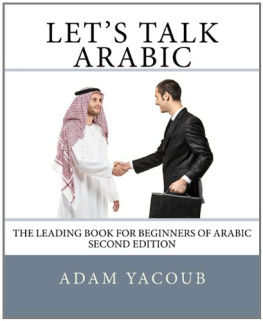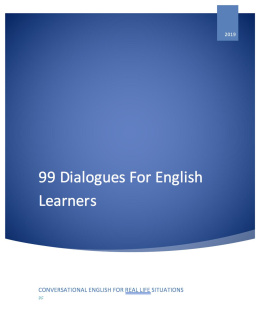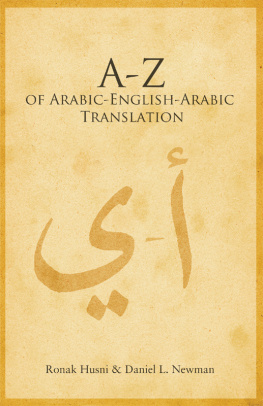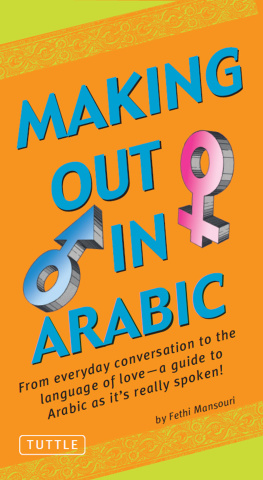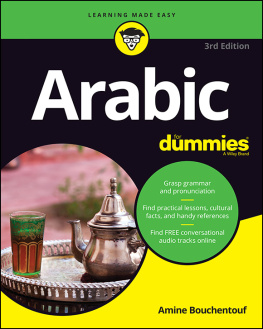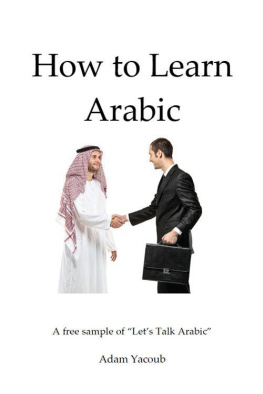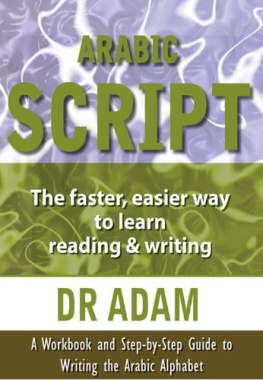Dr. Adam Yacoub - Lets Talk Arabic
Here you can read online Dr. Adam Yacoub - Lets Talk Arabic full text of the book (entire story) in english for free. Download pdf and epub, get meaning, cover and reviews about this ebook. year: 2011, publisher: CreateSpace, genre: Science / Home and family. Description of the work, (preface) as well as reviews are available. Best literature library LitArk.com created for fans of good reading and offers a wide selection of genres:
Romance novel
Science fiction
Adventure
Detective
Science
History
Home and family
Prose
Art
Politics
Computer
Non-fiction
Religion
Business
Children
Humor
Choose a favorite category and find really read worthwhile books. Enjoy immersion in the world of imagination, feel the emotions of the characters or learn something new for yourself, make an fascinating discovery.
- Book:Lets Talk Arabic
- Author:
- Publisher:CreateSpace
- Genre:
- Year:2011
- Rating:4 / 5
- Favourites:Add to favourites
- Your mark:
- 80
- 1
- 2
- 3
- 4
- 5
Lets Talk Arabic: summary, description and annotation
We offer to read an annotation, description, summary or preface (depends on what the author of the book "Lets Talk Arabic" wrote himself). If you haven't found the necessary information about the book — write in the comments, we will try to find it.
Lets Talk Arabic — read online for free the complete book (whole text) full work
Below is the text of the book, divided by pages. System saving the place of the last page read, allows you to conveniently read the book "Lets Talk Arabic" online for free, without having to search again every time where you left off. Put a bookmark, and you can go to the page where you finished reading at any time.
Font size:
Interval:
Bookmark:
 http://www.LetsTalkArabic.com/ This title is also available at major online book retailers. Copyright 2011 Dr. Adam Yacoub All rights reserved. No part of this publication may be reproduced, stored in a retrieval system, or transmitted, in any form or by any means, electronic, mechanical, photocopying, recording, or otherwise, without the written prior permission of the author. eISBN-13: 978-81-8260-085-0 DEDICATION We wish to thank all of those who have kindly helped with introducing this book, every effort or advice had been made to trace all the covered topics but if any had been inadvertently overlooked the author will be pleased to make the necessary arrangement at first opportunity. ACKNOWLEDGMENTS We are lucky enough to have benefited from the experience of some of the experts in teaching Arabic across this edition.
http://www.LetsTalkArabic.com/ This title is also available at major online book retailers. Copyright 2011 Dr. Adam Yacoub All rights reserved. No part of this publication may be reproduced, stored in a retrieval system, or transmitted, in any form or by any means, electronic, mechanical, photocopying, recording, or otherwise, without the written prior permission of the author. eISBN-13: 978-81-8260-085-0 DEDICATION We wish to thank all of those who have kindly helped with introducing this book, every effort or advice had been made to trace all the covered topics but if any had been inadvertently overlooked the author will be pleased to make the necessary arrangement at first opportunity. ACKNOWLEDGMENTS We are lucky enough to have benefited from the experience of some of the experts in teaching Arabic across this edition.
We would like to thank everyone for his or her useful comments on this work. CONTENTS Preface: Unit One: Unit Two: Unit Three: Unit Four: Unit Five: Unit Six: Unit Seven: Unit Eight: Unit Nine: Unit Ten: Unit Eleven: Unit Twelve: Unit Thirteen: Unit Fourteen: Unit Fifteen: Unit Fifteen: Part 1 Preface
Congratulations mabrook Well done for making the fantastic decision to learn the wonderful language of Arabic. For whatever reason it may be, a new challenge, relocation to an Arabic speaking country or for business, you can rest assured that you have made another great decision in choosing one of the most successful and smoothest Arabic courses. This book will lead you to push yourself and take a step above the rest in a fun and interactive way. Arabic is considered to be one of the most alive, important and beautiful languages in the world. This book uses an extremely stimulating, logical and easy way to help you learn from the very beginning.
In any language, speaking appears to be the most fundamental aspect for a lot of people. From the start of the book, you will be introduced to the basics of speaking and pronunciation, using a simple format that allows everyone to speak Arabic in a natural way. The book will then continue to develop your new skills by enabling you to understand and heighten your ability to read, listen to and write this amazing language. Arabic is a Semitic language and is the formal and official language of 22 Arab countries. It is also the spoken language of almost 420 million people living in Arabic and non Arabic countries. This book will teach you the basics of Modern Standard Arabic (MSA), which is the modernization of the Classical Arabic structures, as well as additions from the main dialects spoken all over the Arab world.
Variations of the Language Like any other language, spoken Arabic has some dialects with variations and differences. The differences between these dialects are incomprehensible from one to the other, and can be referred to as five main dialects divided according to their regions. Maghreb The Maghreb dialect is spoken in the region of the Maghreb countries, Libya, Tunisia, Algeria, Mauritania, and Morocco. Egyptian: The Egyptian dialect is used in Egypt, Sudan, Yemen, and some western parts of Saudi Arabia. It is the most widely understood colloquial dialect across the Arab world, because almost 93% of Arabic Movies, TV, and Media use the Egyptian dialect. Levantine The Levantine dialect comes from and is used in Lebanon, Palestine, Jordan and Syria.
The Gulf The Gulf dialect is spoken in the Arabic Gulf Countries, which are made up by Iraq, Kuwait, most of Saudi Arabia, Qatar, Bahrain, the United Arab Emirates, and Oman. Modern Standard Arabic MSA (Modern Standard Arabic) has become the most popular dialect and is now spoken and used by all the Arab countries.  The dark countries on the map show the Arab League. Written Arabic The core of Arabic writing that is used today comes from the classical Arabic which is principally defined as the Arabic used in the Qur'an and in the earliest form of literature from the Arabian Peninsula. Two Important Facts The First is that, any language has a vast wealth of vocabulary, but do we need to learn that vast amount to be able to communicate in a language ? Of course not! Just, 20% of the words in a language make up to 80% of the conversations we face in our daily life. You may not be speaking like a native immediately, but you'll have a solid base and the ability to keep improving and developing yourself.
The dark countries on the map show the Arab League. Written Arabic The core of Arabic writing that is used today comes from the classical Arabic which is principally defined as the Arabic used in the Qur'an and in the earliest form of literature from the Arabian Peninsula. Two Important Facts The First is that, any language has a vast wealth of vocabulary, but do we need to learn that vast amount to be able to communicate in a language ? Of course not! Just, 20% of the words in a language make up to 80% of the conversations we face in our daily life. You may not be speaking like a native immediately, but you'll have a solid base and the ability to keep improving and developing yourself.
This method is suitable for everyone from frequent travelers to first timers, as well as language students and enthusiasts. So, this book focuses on the vital 20% that will help you speak Arabic interactively and dynamically. The second point and this is a really exciting fact. The Arabic language uses word roots, for example, we can take one root like ( KTB ) from the word ( K a T a B a) which means "he wrote" and from there conjugate all Arabic verbs tense. Nouns can also be made from the same root because they have a relation with it. K aa T e B = writer, K e T aa b = book, ma KT a B = office, ma KT a B a= library, ma KT oo b = letter & written, and more.
Arabic grammar is fairly simple compared to Western languages, but the language itself has richness in its vocabulary that exceeds most languages in the Western world. Below is the Arabic alphabet and key to show you how to pronounce them. Try to read paying attention to the pronunciation. 

 UNIT ONE Saying "Hello"
UNIT ONE Saying "Hello"  UNIT ONE Saying "Hello" Contents - - - - - - - Hello! as-salaamu Aalaykum!
UNIT ONE Saying "Hello" Contents - - - - - - - Hello! as-salaamu Aalaykum!  In this lesson you will learn some basic greetings and how to ask "How are you?" A dialogue: Learn as Adam meets an old high school friend, Mahmoud. They haven't seen each other for long time.
In this lesson you will learn some basic greetings and how to ask "How are you?" A dialogue: Learn as Adam meets an old high school friend, Mahmoud. They haven't seen each other for long time.  Vocabulary
Vocabulary Other useful phrases:
Other useful phrases:
 Culture Notes: The most common greeting in Arabic is the phrase "as-salaamu Aalaykum" which means literally "may peace be upon you".
Culture Notes: The most common greeting in Arabic is the phrase "as-salaamu Aalaykum" which means literally "may peace be upon you".
And the most common reply is "wa Aalaykum as-salaam", which means literally "and upon you peace". But as you see in the above phrases, to learn a language, you have to learn its culture, because literal or direct translation doesn't make sense when you speak that language. The same thing in "SabaaH el-khayr" = good morning, and the response of it, which is "Sabaah en-nuur" while "nuur" means literally " light", but this is the way how Arabs greet each others, simply means: if you greet me using good words, so I have to greet you using better words!. Also there is no specific word for greeting in the afternoon. You can use simply either "
Next pageFont size:
Interval:
Bookmark:
Similar books «Lets Talk Arabic»
Look at similar books to Lets Talk Arabic. We have selected literature similar in name and meaning in the hope of providing readers with more options to find new, interesting, not yet read works.
Discussion, reviews of the book Lets Talk Arabic and just readers' own opinions. Leave your comments, write what you think about the work, its meaning or the main characters. Specify what exactly you liked and what you didn't like, and why you think so.

